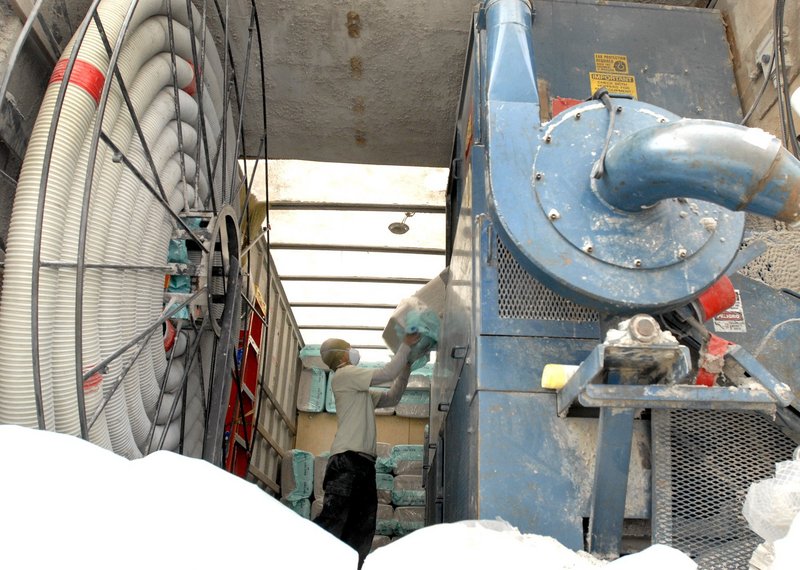Growing demand for home insulation projects last year led Hallowell-based Sustainable Structures to add nine workers, more than doubling its work force. The building and energy services firm needs three more installers, said Curry Caputo, but it has stopped hiring.
A partner at the company, Caputo knows the federal stimulus money that helped homeowners pay for weatherization is almost all spent. Sizing up Maine’s new state government, he doesn’t expect the level of support for energy conservation that was a hallmark of the Baldacci years.
“We are all a little concerned about the future of efficiency funding in Maine,” said Caputo, president of the Maine Association of Building Efficiency Professionals. “It’s all having a cooling effect on our industry and the momentum we’ve gained.”
Maine’s weatherization and energy services industry expanded rapidly after the 2008 oil-price shock, aided by government money and policies aimed at cutting Maine’s dependence on petroleum. The subsequent budget squeeze and the November election have some insulation contractors, energy auditors and other professionals wondering about their futures.
On Wednesday and Thursday, many of these businesspeople will gather in Portland for a second annual training conference and trade show. Along with workshops on insulating systems, indoor air quality and alternative heating, they’ll ponder whether their young industry already has seen its best days for now.
OIL PRICE SPIKE BOOSTED DEMAND
The industry is meeting just as crude oil prices are rising, according to the latest outlook from the U.S. Energy Information Administration. Heating oil averages $3.36 a gallon nationally, up 37 cents from this time last year. In Maine, the price averages $3.10 and has been inching upward.
Heating oil’s brief surge to $5 a gallon set off alarms from Main Street to the State House. The official responses included a new agency to coordinate middle-class weatherization, and an ambitious law aimed at upgrading all homes and half of the state’s businesses by 2030.
These actions corresponded with the availability of $6 million in federal stimulus money for home weatherization, and with generous tax rebates for insulation, windows and certain heating systems.
The incentives and other factors helped create strong demand for energy contractors. Efficiency Maine Trust, which oversees weatherization efforts, recently tallied the results for 2010.
Nearly 3,000 energy audits were done, with 1,670 projects completed and 500 more in the pipeline. The average home is expected to cut its heating costs by 36 percent, or $1,000 per year. The work generated $16 million in spending.
But now the weatherization rebate money, which averaged more than $3,000 per home, is running low. Federal tax rebates have been greatly reduced, too.
If fewer homeowners can afford whole-house retrofits, some businesses may lay off new workers who have recently gone through training and certification programs. At Sustainable Structures, for instance, they earn $15 to $25 an hour.
HELP SOUGHT AS STIMULUS FADES
“I think we’ve peaked for now,” Caputo said. “I don’t expect a lot of new hires in 2011, given the climate. And it’s unfortunate, because we’re going to lose some of these trained individuals.”
A poll done by the trade group found that roughly 60 percent of the new hiring among Maine contractors was linked to the federal stimulus money. As federal money ebbs, some businesspeople have begun reaching out to make their case at the State House.
Contractors invited lawmakers to a trade-group luncheon this month in Augusta to hear about how their industry has created jobs. The meeting was organized by Richard Burbank of Evergreen Home Performance in Rockland. The reaction was supportive, he said, but couched in references to the tough economy.
“We’re going to have a hard selling job ahead of us,” Burbank said.
Burbank’s four-year-old company doubled its work force to 18 last year. He grossed more than $1 million, of which $600,000 went for labor. That money gets circulated in the local economy, he said, rather than leaving the state to buy oil.
The impact of weatherization on the local economy is worth examining more closely, said Dylan Voorhees, clean energy director at the Natural Resources Council of Maine.
While lawmakers may focus on the number of jobs created, he said, the wider financial benefit of weatherization comes from the millions of dollars made available to buy things other than oil. Figures from Efficiency Maine show that the $3,299 average government contribution triggered $6,356 in private spending.
Lawmakers and the new administration of Gov. Paul LePage will get a closer look at the costs and benefits of weatherization from a report compiled earlier this month by the Efficiency Maine Trust. Besides detailing progress so far, it lays out options for future state funding.
On a smaller scale, the trust plans to use a federal stimulus grant to fund a revolving loan program. It also has federal money left over for rebates for high-efficiency heating systems.
OUTLOOK FOR STATE AID DIMS
But the most significant – and likely most controversial – option is to extend to heating oil the fractional surcharge on electricity and gas rates that now helps fund efficiency programs. A so-called systems benefit charge of 2.8 cents per gallon, for instance, would generate $14.3 million a year for weatherization in homes and businesses, the trust has calculated.
The idea of expanding the surcharge didn’t get much traction last year and its chances are even slimmer now, said Rep. Stacey Fitts, R-Pittsfield, the new co-chair of the Energy, Utilities and Technology Committee.
“I don’t see any big support for putting a tax on oil,” he said.
Fitts noted that LePage has yet to designate either an energy director or an energy adviser for his administration.
It’s unclear, he said, whether the energy independence goals of the Baldacci years will continue to be pursued. But it’s more likely, Fitts said, that the energy services industry will need to adapt to a market driven mostly by energy prices, without much help from government.
“Like everything else, it’s a world of diminishing resources,” he said. “We’re going to struggle to replace anything they’re used to.”
Staff Writer Tux Turkel can be contacted at 791-6462 or at: tturkel@pressherald.com
Send questions/comments to the editors.





Comments are no longer available on this story